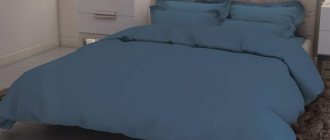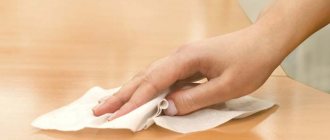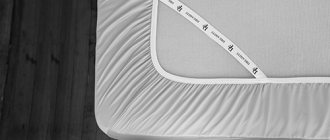Most women in the post-Soviet space are accustomed to carefully ironing their bed linen.
Such conservatism and desire for order were inherited from our grandmothers, who stubbornly boiled, starched, and ironed sheets and duvet covers.
The actions of the ancestors were dictated by hygiene standards. Today ironing is not an urgent need, and many housewives are wondering whether it is necessary to resort to such manipulations.
Why is it not recommended to iron after washing?
Bed linen is ironed for two reasons: disinfection and aesthetics . Smooth sheets and pillowcases, without a single wrinkle, best decorate the bedroom. This effect can only be achieved by ironing the fabric.
A nice bonus to the aesthetic appearance is cleanliness. It's no secret that high temperatures kill most viruses and bacteria.
If a woman does not strive for ultra-cleanliness and an ideal interior, she can afford to give up boring household procedures.
Why can't you iron your bed linen?
There is a logical reason for refusing ironing:
High temperatures destroy fabric fibers. After several washes followed by ironing, the bedding set becomes faded and the colors lose their saturation.- The ironing process has a bad effect on the ability of the fabric to absorb liquid, reducing its hygroscopicity. This fact is most noticeable in the summer months, when after a long sleep you have to dry sheets and pillowcases wet from sweat.
- Not all fabrics require ironing. Materials such as silk, jacquard, calico and boiled cotton practically do not wrinkle. In order to maintain a neat appearance, it is enough to hang them evenly on the dryer immediately after washing, away from direct sunlight.
If the housewife is accustomed to using fabric softener during washing, it is advisable to abandon the use of a classic iron.
The fact is that when heated, particles of household chemicals remaining in the fabric easily enter the air and, with their pungent odor, can cause allergies. In such cases, it is better to iron the washed clothes with steam.
Ironing bed sheets: pros and cons
Many housewives like to iron textiles, and they don’t even think that they can do without this procedure. Why do you need to treat fabric?
There are really many advantages to ironed laundry:
- neat appearance. Ironed linen is associated with cleanliness, hygiene and cleanliness of a person; it is not a shame to lay it out for guests;
- after ironing, the bed becomes soft and pleasant to the body (except for terry sheets, which become stiffer and thinner);
- due to the structuring of fabric fibers, the wear resistance of bedding increases;
- Heat treatment kills harmful microorganisms and bacteria, mite larvae, etc.
The ironed set becomes more compact and takes up less space on the closet shelf
Although ironing has a number of advantages, this approach also has a lot of disadvantages:
- During heat treatment, the pleasant aroma of laundry detergents decreases or completely disappears.
- Ironing worsens the hygroscopicity of the fabric, so the laundry absorbs moisture less well. During sleep, a person sweats, and if the bedding does not absorb sweat, then the secretions remain on the skin and clog the pores, which negatively affects health.
- To iron all the bulky items from the set, you need to spend a lot of effort, time and energy, including electrical energy. If there are several sets, this may take a whole day.
- After ironing, some types of bed textiles become electrified, which negatively affects a person’s proper rest and comfort during sleep.
If you wash and dry your items correctly, your laundry will look aesthetically pleasing without ironing.
To know whether you need this procedure, you should weigh all the pros and cons and decide what is fundamentally important to you and what is not.
What do folk signs say?
Every thing in the house has its own energy, the bed especially . A person spends more than 1/3 of his life in it, so there are quite a lot of folk signs associated with bedding.
There is a popular opinion that bedding must be ironed. Regular sleep on crumpled sheets attracts difficulties and failures to a person, darkening his life.
Our ancestors believed that wrinkled linen was the favorite habitat of evil spirits, who sucked energy and vitality out of a person during sleep.
How to carry out treatment after purchase so that it does not fade or shrink?
Before you start washing for the first time, you should consider the information provided on the product label. In most cases, the temperature limit for processing colored bed linen is limited to +40ºС, but a higher value is possible. For the first wash, you can limit yourself to even +30ºС.
Almost all sets are allowed to be processed in a washing machine. Exceptions are most often associated with the characteristics of the composition (for example, natural silk) or the implementation of design techniques (the presence of complex additional elements, etc.).
The following recommendations will help you carry out your first wash simply and without unpleasant consequences:
- The detergent is chosen taking into account the composition of the fabric. Liquids are preferable to powdered ones, as they dissolve better and are easier to wash out when rinsing.
- Bleach is not used during the first wash, even for white items.
- If several bedding items from different sets are sent for the first wash, they must first be sorted by color and material composition.
- All things are turned inside out.
- Intense friction is not required when processing new items for the first time.
- Selecting a mode on the washing machine is in accordance with the type of fabric under the conditions recommended by the manufacturer. But you can use a delicate wash for the first time.
- When washing a set intended for a child, it is recommended to use baby detergent.
You will find a lot of useful information about washing bed linen in this section.
If not an iron, then what?
There are many alternative ways to iron laundry. For these purposes, it is not necessary to use a classic iron with a heating surface .
How to make your bedding look neat:
- If, due to the delicate composition of the fabric, it is not possible to iron it, you should use a non-contact method of smoothing the surface using hot steam. This method does not dry out the laundry, as a result of which the made bed will not irritate the skin or become electrified.
- You can also iron things in a washing machine. This is made possible thanks to the easy ironing function. The principle of operation is that the laundry is spun at low drum speeds, as a result of which the fabric does not wrinkle and there are no creases left on it. Items washed in this way do not need to be ironed - just hang them on the clothesline immediately after removing them from the machine.
- Adding fabric softener will soften the fabric fibers and make them more elastic. By hanging it to dry while wet, you can save yourself the ironing process.
Flaws
Even though the procedure has a lot of advantages, it is impossible to confidently answer the question of whether to iron after washing, since it is worth considering other disadvantages of this process:
- The aromas that fill sleeping sets after washing almost completely disappear when ironing. As a rule, many housewives use special conditioners to clean and add aroma.
- Ironing the entire set, as a rule, takes too much time, and also consumes a lot of electricity, since modern irons consume electricity on a significant scale.
- After ironing, the surface of the bed linen becomes less susceptible to absorbing moisture, which appears every night due to natural human sweat.
- Some bedding materials can accumulate electricity after ironing. This adds significant discomfort to a person, making his sleep less comfortable.
When is this absolutely necessary?
to iron bed linen only in two cases:
- if a person with skin diseases lives in the house;
- if a newborn child appears in the family.
The skin of a newborn baby cannot always withstand an aggressive external environment. This is especially true for the period when the umbilical wound has not completely healed.
At this moment, ironing the baby’s bedding, from a pediatric point of view, is a mandatory procedure. Moreover, it is advisable to iron the fabric both from the outside and from the wrong side .
Heat treatment protects against infection by fungi and bacteria that were found in a sick roommate.
If one of the family members has been diagnosed with scabies, it is necessary to iron not only bedding, but also bath towels.
Tips for ironing bed linen
- Wet laundry will be ironed better.
- Select the temperature mode based on the type of fabric.
- Iron delicate, silk linen from the wrong side, using the most gentle iron setting and without wetting. Drops of water leave stains on the fabric.
- A cotton bedding set can be easily ironed with a hot iron. Steam or irrigation mode will only speed up the process. It’s better not to let it dry out and iron it slightly damp.
- Terry sheets should not be ironed, otherwise they will become stiff and less fluffy. After washing, they are spread on the surface and dried. This way there will be no creases or folds on them.
- Sleeping sets made of all types of fabric, except silk, are ironed right side out. The direction of movement of the iron is along the length, so that there is no stretching.
- Satin bedding sets are ironed exclusively from the inside out. The steam function cannot be used.
- For synthetic and mixed fabrics, use a warm iron, which is applied from the wrong side.
- To speed up the process, sheets and duvet covers are folded several times and ironed on each side.
- An iron with a steamer can handle dry items. The steam generator quickly irons and refreshes laundry.
- The final stage of ironing should be airing, during which the bedding cools and dries.
We suggest you familiarize yourself with How to compactly fold things into a suitcase so that everything fits
When it is not possible to iron right away, the linen is folded, matching the corners. Creases and folds need to be ironed. Pillowcases and duvet covers are fastened. The sheet and duvet cover are folded 2-3 times. The stack is left on a flat, hard surface. You can press it on top with a press. Before ironing, all you have to do is spray it with a spray bottle and give it time to absorb moisture.
Yes or no?
There is no exact answer to this question . Each housewife makes a decision based on her own beliefs. However, most European women have given up ironing bed linen.
Of course, an ironed bedding set looks great on the bed. But the neat effect disappears after the first use.
If it is fundamentally important for your family to go to bed in a perfectly ironed bed, you should give preference to products made from wrinkle-resistant fabrics .
What do they say on the forums?
If we analyze the most popular women's forums that discuss the issue of mandatory ironing, we can conclude that most housewives will part with their iron without hesitation.
This discussion clearly confirms the above. Almost all participants in the discussion answered that they do not iron bed linen, and at the same time do not experience discomfort during sleep.
In their opinion, in order to give the fabric a neat look, it is enough to hang it on a clothesline in a wet state, aligning the corners .
How to iron bedding correctly?
- Maintain the correct temperature, especially if you need to iron items made from delicate fabrics. Remember that silk fabric must be processed at a temperature of no more than 50 degrees, but if you are dealing with cotton or calico, the temperature can reach 200 degrees.
- Monitor the condition of the soleplate of your iron, which should be kept clean. Otherwise there is a risk of tissue damage. If plaque appears on the sole, you can clean it using baking soda. If there is no particular dirt on the surface, you should simply wipe the soleplate of the iron with a piece of clean cloth.
- There is no need to put things in cabinets and on shelves immediately after finishing the ironing procedure, as they must dry to avoid creases. The following conclusion follows from this: iron the products until dry.
- It is strictly not recommended to iron lengthwise, as the fabric may stretch.
- Place items in cabinets only when they are at room temperature.
- Before you start ironing, you need to straighten the corners and folds, and the places that have already been ironed should be folded in such a way that the products do not wrinkle.
- As practice shows, it is best to iron things when they are still slightly damp. Then it is easier to smooth the fabric and this will improve the quality of heat treatment. You can moisten the products a little yourself using a spray bottle or if your iron has a corresponding function. Sometimes it is recommended to wrap things that are too dry in damp towels (terry).
- It is better to iron the bedding from the front side, while using the iron you need to process the entire length.
- Ironed bedding sets must be allowed to cool and ventilate, and after half an hour you can already make the bed with them.
Delicate silk items should be processed using the delicate setting. This type of item needs to be ironed from the inside out while it is still damp. Do not splash the silk with water, otherwise you risk leaving a stain on it. You can safely iron cotton linens at high temperatures using steam and spraying water. It is generally not recommended to iron terry linen, as it will lose its appearance. Simply smooth it out while it is still wet and let it dry.
Using these tips, you will be able to make a choice whether the procedure of ironing bedding will be mandatory for you, and if the answer is yes, you will do it correctly, efficiently and without unnecessary effort.










